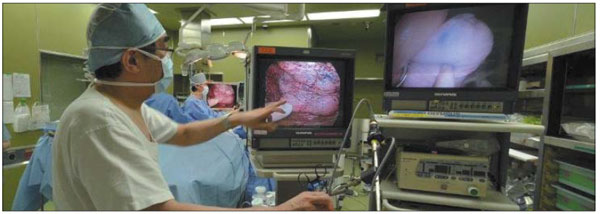3D printed organs offer realistic practice models
An incision from the surgeon's scalpel sends liquid oozing over the surface of the lung, but on this occasion it doesn't matter if something goes wrong - the doctor is working on a model made by a 3D printer.
The realistic lung, which is wet, soft and complete with blood vessels, is one of a range of organs being produced by a Japanese firm to help surgeons hone their skills without the risk of human harm.
"With the wet model, doctors can experience the softness of organs and see them bleed," said Tomohiro Kinoshita from creator Fasotec, based in Chiba, southeast of Tokyo.
"We aim to help doctors improve their skills with the models," he added.
From guns to cars, prosthetics and works of art, 3D printing is expected to transform our lives in the coming decades as dramatically as the Internet did.
The so-called Biotexture Wet Model, which is due to come onto the market for surgery training and medical equipment-testing in Japan this month, is created by scanning a real organ in minute detail and creating molds on a 3D printer.
The shell is then injected with a gel-type synthetic resin to give it a wet, lifelike feel in the surgeon's hands.
Each model is designed to exactly mimic the texture and weight of a real organ so it can react to the surgical knife in exactly the same way.
Like a living organ
Maki Sugimoto, a medical doctor who tried samples of the models, said the wet models were almost "too realistic".
He said out of context it would be easy to mistake the models for the real thing.
"The touch is similar to that of the real liver," said Sugimoto, who is also a special instructor at Kobe University Graduate School of Medicine in Kobe, western Japan.
"I suppose that not only young, inexperienced doctors but also experienced doctors can perform a better operation if they can have a rehearsal first," he said.
Toshiaki Morikawa, a medical doctor at Jikei University Hospital in Tokyo, said: "The current models are too simple and details of anatomy are not accurately reflected.
"But this is obviously superior as it's produced precisely and is very close to the living organ in quality," he said.
For Morikawa, the world of 3D printing, which works by building up layers of material, offers endless possibilities for medicine, including eventually creating functional organs for use in transplants.
"Considering future progress in life sciences, I think it is an urgent and significant theme that this outstanding technology should be modified for application to biology," he said.
Fasotec began pre-sales of wet model bladders and urethral tubes in October, with a price tag of 15,000 yen ($127).
The firm plans to expand sales overseas and has already received enquiries from other Asian countries, Kinoshita said.
|
Professor Toshiaki Morikawa gives a lesson while using a 3D-printed lung at Jikei University Hospital in Tokyo. |
(China Daily 04/16/2015 page15)















